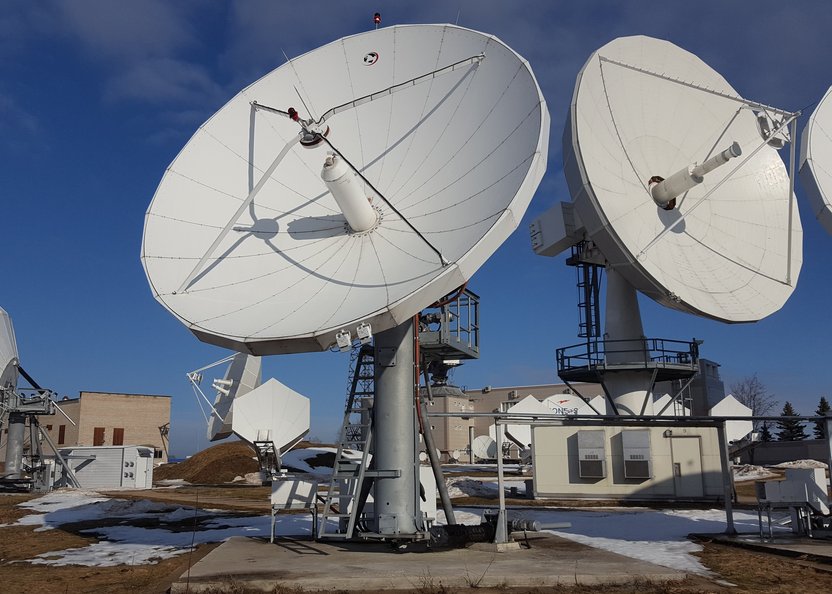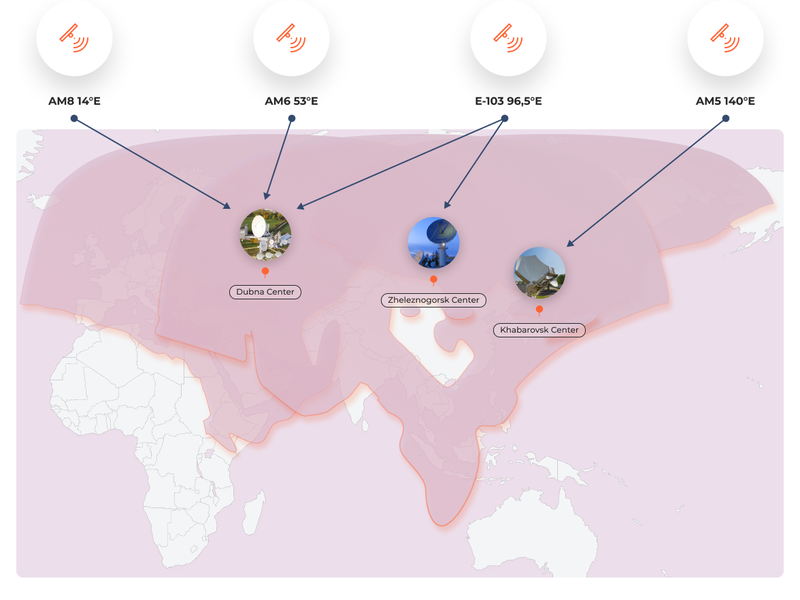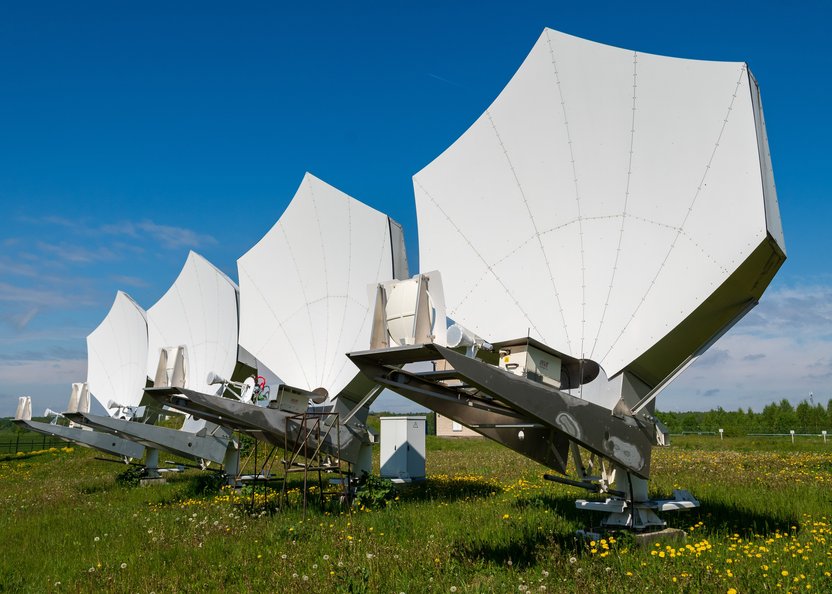
Communication services
RSCC organizes satellite communication channels of various configurations for companies in almost all sectors of the economy. The use of modern satellites of the "Express" series and the own fiber-optic network of the RSCC, coupled with the leading telecommunications companies in Moscow and international switching centers, allows us to offer comprehensive information transmission services to state and commercial companies, Internet providers, operators of communication networks, including cellular . RSCC creates and integrates corporate communication networks, organizes telephone communication channels, broadband access to the Internet, video conferencing and IP telephony.
The main advantage of RSCC's maritime VSAT technology is much higher data rates of the satellite channel. For example, the data rate in RSCC's maritime VSAT network is reaching 45 Mbps (per vessel), and this is not a technical limit. At the same time, the channel through a foreign system using the most powerful equipment such as Sailor FBB-500 (Fleet Broad Band) would be times slower: up to 432 kbps per vessel.
The cost of 1 MB of IP traffic passing through RSCC's maritime VSAT equipment is 0.45 rubles, which is way smaller than with the foreign system where the cost is 6.5 rubles per 1 MB. The cost difference is 14 times.
RSCC offers its customers unlimited tariffs, which is convenient when planning the budget for communications. The foreign system offers no such opportunity. In addition, fluctuations in the ruble exchange rate carry the risk of unplanned expenses.
The foreign system and the maritime VSAT from RSCC operate via satellites located in GEO, i.e. in the circumpolar coverage area the limitations are almost identical.
The main disadvantage of the marine VSAT system is the high cost of equipment, which starts at $40,000.
For comparison, the most expensive system, Sailor FBB-500, working through the foreign system, costs $16,000.
For ships in the Caspian and the Black sea, on the Northern Sea Route, in the seas of Europe and the Far East, RSCC offers its VSAT networks based on Express-AM6/103/AM5 satellites. There is roaming between VSAT networks on these spacecraft.
Latitude communication is available from 79°-80°S to 79°-80°N. The basic frequency band of the VSAT networks is Ku-band, but on request for some solutions C-band can also be implemented.
Here are the basic steps to do and prerequisites to follow to get a vessel's satellite station connected to RSCC's VSAT network:
- Fill out the online questionnaire for RSCC experts to assess if an 'easy' connection of the satellite station to RSCC's VSAT will be possible.
- Send the specification of your satellite equipment and field devices and their connection diagrams to RSCC.
In the event of inconsistency between technical performance and composition of your equipment, you may need to upgrade it and make some settings on it.
The vessel needs the following installed:
- Ku-band stabilized maritime antenna of the proper type (SeaTel-4012, SeaTel-5012, SeaTel-6012, KNS Z10 Mk2/Mk3, KNS Z12 Mk2/Mk3, KNS Z15 Mk2/Mk3, Sailor-900, Intellian V130, Orbit OrSat™ Global) with the reflector diameter 1.0 meter or bigger, transmitter (BUC) of 4 W or higher, preferably supporting the OpenAMIP protocol. For a C-band satellite station antenna: reflector diameter of 2.0 meters or bigger, transmitter (BUC) of at least 25 W;
- Satellite modem;
- Stabilized maritime antenna system, properly installed, with minimal cut-off angles;
- Vessel's LAN additional Ethernet-compatible field equipment;
- Antenna controller connected to vessel's GPS and heading reference systems.
These are the basic requirements for the equipment available on board a ship.
Here are the key steps to get a vessel with no satellite station connected to the RSCC's VSAT network:
- Get a technical inspection (field visit) of the place where you are intending to install VSAT on your ship.
If no such possibility exists (the ship is far away or on a trip), you need to send to RSCC information on the design of 2 upper decks of that ship: photos/diagrams of the decks, captain's bridge, information concerning the technical possibility of laying cables from the antenna to the place where your underdeck equipment is installed (usually this means the radio cabin, the server room, or the bridge). RSCC experts will review your information and recommend a place for the antenna.
- Coordinate the composition and the technical data of the equipment with RSCC (depending on the services arranged on your ship).
- Buy an approved set of equipment from suitable vendors.
- Install the antenna system, RF cables and underdeck equipment as designed, connect the equipment to onboard GPS and heading reference systems, and load the appropriate settings into the satellite modem.
- Enter into standard contracts for the VSAT communication services and for the installation and commissioning work.
RSCC staff is ready to organize, on contractual basis through a contractor, equipment installation work, to do the final touch on the VSAT equipment settings, including also the field devices needed for its operation in the RSCC VSAT network, with connection to various telecommunication services and to the Internet.
Once the conditions to install RSCC-recommended equipment and obey the communication arrangement scheme are met, the following services will be available onboard the ship:
- Exit to the public urban telephone network through the shipowner's PBX/telephone line of the VoIP technology;
- Service Internet access;
- Separation of access networks by consumers on the ship;
- Remote access to the shipowner's local bandwidth;
- Video surveillance onboard and around;
- Tracking the ship (on the map) in real time;
- Connection of shipboard telemetry sensors;
- Individual Internet access for crew members and payment for the service through an electronic billing system;
- Remote monitoring of shipboard equipment;
- Collection, transmission and storage of telemetry, cartographic and navigation information;
- Telemedicine;
- Reception of open TV programs.

Communication services for stationary objects and vessels
The RSCC's VSAT network provides communications services for stationary objects and vessels across Latin America, the Caribbean islands, the east and southeast coasts of the United States, Africa, the Middle East, Russia, seas of the Arctic, Atlantic and Pacific Oceans. The RSCC's VSAT nerworks operates via Express-AM8, Express-AM44, Express-AM7, Express-103 and Express-AM5 satellites. It includes five central HUBs located in Dubna, Zheleznogorsk and Khabarovsk space communication centers and a control center.


Russian Satellite Communications Company, trough of its own space communication centers, offers its customers an out-of-the-box technological platform that provides solutions for a wide range of tasks:
- provision of bandwidth of space communication centers for transmission and reception of satellite communication channels;
- access to its own as well as third-party satellites in geostationary orbit;
- 'last mile' delivery of communication channels and connections to switching centers in Moscow, Krasnoyarsk, and Khabarovsk;
- creation of terrestrial networks based on its own and leased communication lines with a ring topology to provide 100% redundancy of terrestrial communication channels;
- connection of telecom operators according to VNO model;
- placement and operational and technical maintenance of telecom operators' equipment in the equipment rooms of the space communications centers and the Shabolovka TC;
- monitoring and round-the-clock management of satellite communication channels and networks for the benefit of customers;
- our own 24/7/365 technical support service.
